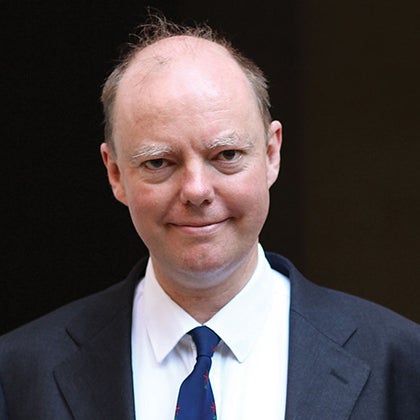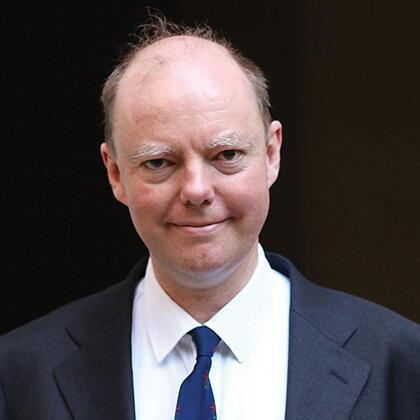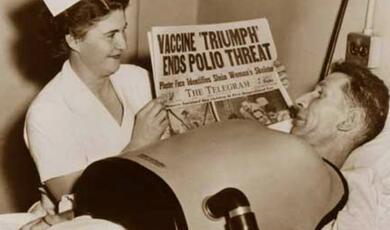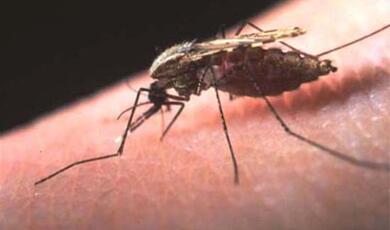Rhythm Disturbances of the Heart
Share
- Details
- Text
- Audio
- Downloads
- Extra Reading
Our bodies depend on our hearts maintaining a steady beat, and increasing it appropriately in response to exercise. If the heart goes too fast, or too slowly, we have effects ranging from tiredness to unexpectedly passing out to death.
This lecture will consider the normal heartbeat, the causes of the heart going too fast or slowly and how it is treated when it does.
Download Text
Rhythm Disturbances of The Heart
Professor Chris Whitty
21st February 2023
The heart normally beat steadily and very efficiently. In humans it has a resting beat typically between 60 and 100 beats per minute (bpm), lower in the very fit. It can rapidly accelerate up to 130-150 bpm if needed for physical exertion, stress or infection. Other mammals have different set beats: blue whales can drop to 4 bpm in dives while some land mammals such as the Etruscan pygmy shrew can have beats of over 1000 bpm. This lecture will consider what happens in humans when the heart beats too fast or too slowly. These notes indicate what the lecture will cover and are not a transcript.
Three broad groups of things can lead to the heart failing or stopping. Lack of oxygen due to coronary artery disease was covered in the last lecture, and the final lecture of the series will consider damage to the structure of the heart. This lecture considers heart rhythm abnormalities, generally termed arrythmias: too fast (tachycardia) or to slow (bradycardia).
Understanding the structure of the heart is important to understanding normal and abnormal rhythms. Everyone will have learnt this in school, or subsequently, but as revision there are four chambers. The heart is in practice two separate pump systems which beat together; the left side pumps blood around the body whilst the right side pumps blood around the lungs. In both there is an upper chamber, the atrium, and a more powerful lower chamber the ventricle. In a normal heartbeat the atrium contracts pumping blood into the ventricle, which then contracts pumping blood around the body. Getting the sequence right with the correct timing is essential for optimal heartbeats.
To achieve this sequence the heart has a sophisticated electrical conduction system. Atrium contraction is initiated at a specialised pacemaker, the sino-atrial node (SA node). From this electrical wave spreads over the atrium rapidly leading to a synchronised atrial contraction. There is then a deliberate delay as the impulse passes through the atrioventricular (AV) node. Then the electrical impulses are rapidly conducted around the whole ventricle by the specialised bundle of His and Purkinje fibres and spreads out from there. This ensures a synchronised ventricular conduction after the atrial conduction.
The heart has an ability to adjust speed under normal functioning. The SA node can speed up or slow down; the sympathetic nervous system speeds it up and the parasympathetic slows it down. For optimal heartbeats the whole system has to be working but the heart has escape pacemakers if it is necessary and some part ceases to function. The AV node has a pacemaker that is slower than the SA node and can take over if the SA node fails; generally this is 40 to 60 bpm. Finally, Purkinje fibres have a very slow pacemaker that can take over if the AV node fails as well generally at 20 to 40 bpm.
How the sympathetic and parasympathetic systems control the heart is important for response and also is the basis on how some of the key drugs work. The sympathetic system (fight or flight) releases norepinephrine/noradrenaline. This has multiple effects on the body but for the heart rhythm mainly affects beta-1 adrenergic receptors. These increase heart rate in the SA node and the speed of conduction in the AV node. The parasympathetic system uses acetylcholine to slow the pacemaker and AV speed of conduction. During exercise, first the parasympathetic system reduces and then the sympathetic system kicks in.
In the last lecture I talked about how the ECG (electrocardiogram) is very important to diagnosing the most serious heart attacks. It is also central to diagnosing heart rhythm problems. The modern ECG was developed in stages from the 1880s. It works because the heart beating releases a big enough electrical impulse to be measurable on the surface of the body. It tells us a lot about heart rhythm disturbance. The lecture explains the key points of the ECG.
ECGs run at a standard speed and it is therefore possible to tell how fast the heart is going. People presenting with arrhythmia, whether fast or slow can be identified in multiple ways. The rhythm may be identified in routine testing for example before an operation with no previous symptoms. Some people have palpitations but no serious symptoms; often these are of no importance at all but can sometimes indicate heart rhythm changes. More serious symptoms can include intermittent dizziness, faintness, chest pain, new onset shortness of breath and in severe cases collapse or severe shortness of breath. The most severe emergency presentation of arrhythmia is cardiac arrest which will rapidly lead to death is not treated.
Sometimes it is possible to diagnose someone with fast or slow heartbeat at rest with a one-off ECG but often people have intermittent symptoms that could be arrhythmia. Holter monitors store all the rhythm over a prolonged period and can identify runs of arrhythmia over 24 hours or longer during normal activity or during exercise.
Bradycardia - The Heart Beating Abnormally Slowly
Sinus bradycardia is when the heart is beating very slowly, but the sequence of contraction of the atrium and then the ventricles follows the usual sequence. This can be normal for example in athletes. It may however be due to a number of diseases many of which are reversible. These include hypothyroidism, hypothermia, some drugs, some infections and recent myocardial infarction.
Sick sinus syndrome is when the sinoatrial node initiates contractions too slowly or too fast (or both). This is generally age-related but can lead to an irregular heart rhythm. Again the sequence of atrium and then ventricular contraction is normal but the rhythm is not. The lecture also considers sinoatrial block.
Another form bradycardia is atrio-ventricular (AV) node block. This can be first or second degree block with certain types of second degree block being the more important. ECG appearances of this will be covered in the lecture. Finally at the AV node there may be complete heart block. The atrium is contracting normally, and the ventricles are contracting at a slower rate but there is no relationship between them.
Bradycardia is generally important when it is symptomatic. Sometimes there is a reversible cause such as drugs and in that case the key thing is to reverse them. As a holding manoeuvre during a temporary bradycardia is possible to use drugs to speed up the heart especially atropine and epinephrine (adrenaline). It is also possible to do external pacing through pads on the skin. This should only be seen as a temporary measure and is uncomfortable. Most people need a permanent pacemaker unless the cause is reversible.
Early pacemakers were large, external and only for severe cases. Pacemakers are now extraordinarily small, long lasting and effective in bradycardia, and they are developing the whole time. Currently pacemakers are inserted under local anaesthetic and have batteries which lasts 6 to 10 years. All pacemakers give a very small electrical impulse which initiates the contraction of the heart. Most current pacemakers work on demand; they only fire if you miss beats or the heart is too slow but not if the heart is beating normally. Often they now sense if the bodies moving or breathing fast and speed up – rate responsive. They can be single-chamber either in the atrium or the ventricle, or dual chamber (both atrium and ventricle) or biventricular with three leads. There are many possible settings depending on the problem.
Atrial Fibrillation
Atrial fibrillation (AF) usually, but not always, causes a tachycardia. AF is when the atrium is contracting uncontrollably like a twitching bag. The result of this is the atrium provides no pumping at all and the ventricle usually contracts irregularly. This is less efficient than the normal heartbeat and can lead to breathlessness and heart failure. It may drive the heart very fast. It also significantly increases the risk of stroke as clots can form on the wall of the atrium. Atrial fibrillation increases with age and is rare for those under 50 years old.
Atrial fibrillation may be temporary. It can be triggered by physiological stress such as sepsis or surgery. Alcohol and some drugs including caffeine, cocaine and amphetamines make it more likely. An overactive thyroid also increases the probability, as do some heart valve abnormalities. If there is an obvious cause stopping the cause may lead to it resolving. If there is no cause but there is recent onset it may be possible to shock the heart out of it (DC cardioversion). Some drugs may also lead to cardioversion including amiodarone and flecainide.
In many older people atrial fibrillation becomes established and permanent. When this is the case there are two priorities. The first is to slow the heart down to a roughly normal rhythm and the second is to have adequate anticoagulation to reduce the risk of stroke. The oldest drug for slowing the heart is digoxin, originally discovered via work on foxgloves by Dr William Withering in the 1780s. Beta blockers and calcium channel blockers are also potentially used, and currently are likely to be the earliest treatment. All these drugs lead to a slowing of impulses through the AV node by different routes. Beta blockers and calcium channel blockers have been covered in a previous lecture due to their importance in reducing hypertension and will be further discussed in this one.
Any patient who has prolonged or permanent atrial fibrillation is likely to need anticoagulation (blood thinning). Atrial fibrillation is associated with a higher risk of stroke and if there are other risk factors this goes even higher. There are various scoring systems to determine the risk of stroke (high scores make blood thinning more important) and also the risk of bleeding (high scores make blood thinning more dangerous). The drug that was used most widely was warfarin but now the most commonly prescribed group for new cases are directly acting oral anticoagulants (DOACs).
In some people it is possible permanently to stop atrial fibrillation by a procedure called cardiac ablation. This finds areas of the atrium which are causing the condition and scars them to prevent the rhythm. This is performed via catheter which is usually fed in from the groin up into the heart. There may be a need for a pacemaker afterwards.
Some people have intermittent atrial fibrillation also known as paroxysmal atrial fibrillation (PAF). In some this is controlled by taking drugs continuously which make it less likely. In others it is treated by a “pill in the pocket” where people only take treatment when they have symptoms.
Tachycardia
Tachycardia is when the heart is beating abnormally quickly. Sinus tachycardia is when the heart is going fast but it is a normal contraction with the atrium followed by the ventricle. This can be normal in exercise or stress. It may however be a sign of sepsis or infection, shock or blood loss, or hyperthyroidism amongst other causes. In abnormal forms of sinus tachycardia the key is to treat the cause such as infection or blood loss.
Other tachycardias arise from the heart itself. A common one is atrial flutter. In this the atrium is contracting at between 280 and 300 bpm. The ventricle then can be beating on a one-to-one ratio, or with a 2-to-1 block at the AV node leading to a ventricular rate of around 150, or a longer block. It is usually easier to terminate than atrial fibrillation. Ablation is usually very successful when appropriate.
Other tachycardias are divided into supraventricular where the tachycardia comes from above or in the AV node, and ventricular tachycardia when it comes from below the AV node. Supraventricular tachycardia are usually narrow complex ECGs. Several things can give rise to this including abnormal firing of the heart muscle cell, re-entry of the electrical wave which is part of the ventricle going back into the atrium or a condition called Wolf-Parkinson-White syndrome. Supraventricular tachycardia is often temporary but may recur. It may be possible to terminate it by stimulating the parasympathetic system for example getting the patient to blow against resistance. Several drugs can cause a temporary AV block which may terminate it. In more severe cases DC cardioversion (shock) may be used. In the longer term drugs can be used to slow transmission in the heart and reduce the chance of recurrence, or cardiac ablation may be used as in atrial fibrillation.
Ventricular tachycardia is from below the AV node and usually causes a broad complex tachycardia. It is generally more severe than SVT and therefore often a medical emergency. It can be life threatening. Drugs which work on the AV node are not relevant. If there is time for drug treatment then the drug amiodarone can be used but in urgent settings DC cardioversion will be used particularly if there is low blood pressure or other major risk.
Pacemakers and implantable defibrillators are sometimes used in tachycardia. Block-and-pace is a technique to use drugs to slow the heart and a pacemaker to kick in if this goes too slowly. Ablate and pace is where cardiac ablation scars the tissue causing the tachycardia, and the pacemaker prevents the heart going too slowly afterwards. In some people who have ventricular tachycardia or other dangerous rhythms regularly it is also possible to have an implantable cardioverter defibrillator which administers a localised shock to the heart when a dangerous rhythm occurs.
Cardiac Arrest
Cardiac arrest is the most dramatic and dangerous manifestation of an arrhythmia. It is usually sudden with the patient collapsing and having no pulse. Where the problem is from the heart the may be rhythms which respond to DC cardioversion. These can include ventricular fibrillation where the heart is twitching rapidly, and ventricular tachycardia without a pulse. These kinds of rhythm are most common after a heart attack.
Outside of hospital settings the most important thing to undertake is CPR- cardiopulmonary resuscitation. This is an essential first aid skill. Rapid compressions of the chest pump enough blood around the body and brain to keep them viable for a while. This should be used whilst waiting for help: phone 999 first. CPR alone can be used with minimal training. Adding rescue breaths to top up the oxygen usually needs basic first-aid training. Cardiac arrest teams in hospitals and paramedics in ambulances are trained to use both drugs and defibrillators to try to terminate a cardiac arrest. There are increasingly automatic defibrillators available in many public sites and they both diagnose and administer a shock even in the absence of a trained user.
Prevention and Conclusion
Generally prevention of arrhythmia is achieved by keeping the heart young. Things that are good for the heart generally reduce the risk of arrhythmia. These include stopping smoking, exercise, reducing hypertension and cholesterol. Alcohol in excess and some recreational drugs increase the risk of arrhythmia. Some medical drugs also make it more likely.
Bradycardia and tachycardia are important conditions which can lead to the heart to function inefficiently or fail. We already have however a significant number of countermeasures including very good diagnostics, pacemakers, drugs, DC cardioversion and ablation.
© Professor Whitty 2023
Part of:
This event was on Tue, 21 Feb 2023
Support Gresham
Gresham College has offered an outstanding education to the public free of charge for over 400 years. Today, Gresham College plays an important role in fostering a love of learning and a greater understanding of ourselves and the world around us. Your donation will help to widen our reach and to broaden our audience, allowing more people to benefit from a high-quality education from some of the brightest minds.


 Login
Login







